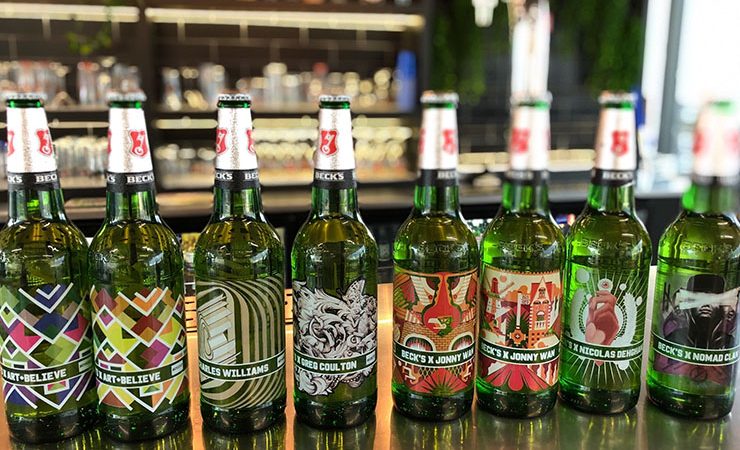At a site on the outskirts of Leuven, Belgium, Anheuser-Busch InBev (AB InBev) is pioneering a new way to decorate glass bottles.
This is founded on the application of UV inkjet technology to prepare, print, finish, and even emboss bottles. CMYK, coupled with white and varnish, is allowing the creation of photorealistic images and other premium decoration techniques directly on the glass surface, in ways that are claimed as previously unachievable with the likes of screen printing, digital label printing, and shrink sleeves.
‘There are so many possibilities,’ says Simon Gerdesmann, manager of the Tattoo Alpha Print (TAP) site where the line is located. ‘You can print pictures, 360-degree decoration, create a ‘no label’ look and feel, introduce variable data and unique elements, and augment the physical bottle with embossing – there are lots of ideas and potential. This is all achieved with a super-premium appearance, from one to one million bottles.’
He continues, ‘It allows us to directly respond to the market, such as decorating a batch of bottles that are targeted at a speci c sporting or music event. This opens up the potential to tap into hyper-customisation, and the wider move towards small batch, local food and beverage manufacturing.’
Developed in partnership initially with Till Engineering, which was then acquired by Krones and became Dekron, the alpha line has a commanding footprint that includes multiple quality control stages, pre-treatment and drying stages to ensure the bottles meet the specifications required to make them receptive to inkjet printing.
The all-important printing stage features nine modules, each with two sets of printheads, stacked on top of each other. Upon entering the print section of the line, the bottles are first printed with white, before moving up to the print area where CMYK is applied in a single pass.
Bottles then move back down to be varnished, before leaving the print module and entering a UV curing tunnel. A coating is applied to ensure the right slip properties. The bottles are then moved onto logistics, palletised and packed, ready for shipping to different markets.
A clear varnish is used to replicate embossing by applying multiple layers depending on the design and depth required. Cost savings associated with creating a mould to produce thousands of bottles is an obvious win for this application of the technology, although Mr Gerdesmann is keen to note the knock-on impact for brands in terms of consumers and their impression of such bottles.
‘Digital embossing creates a tactile effect that appears to be part of the bottle. This allows exibility and uniqueness in the design and creation of bottles. By coupling it with colour printed decoration, it is possible to create a really premium look and feel.’
Tattoo
In a landmark project that saw the technology placed directly into the hands of consumers, more than 200,000 bottles of Becks beer were decorated using direct digital printing. Sold via Sainsbury’s supermarkets in the UK, Mr Gerdesmann notes that the project had a positive impact on sales and served to prove the viability of digital direct-to-glass decoration.
Mr Gerdesmann now has aspirations to see manufacturing ramped up at the TAP site and greater utilisation of the line’s capacity. At the same time, the focus is turning to applications for the next-generation of digital direct-to-bottle lines.
This aspiration is shared by Dekron/Krones, which are focused on advancing industrial digital decoration of containers in the beverage industry. The first steps in this direction were taken in 2006.
While a big focus is on the decoration of cylindrical glass containers, as exampled by the TAP line, there are four machines in its portfolio that are tailored to different manufacturing levels and different substrates.
‘Now it’s been shown to work, it’s getting interesting,’ says Mr Gerdesmann. ‘People are getting to know and understand the capabilities possible with this technology, while in the background we are working to develop the technology, scale it down with a smaller footprint, and remove some of the complexity from the process.’
He adds, ‘The move to smaller, more personalised manufacturing, coupled with the evolution of decoration technology will come together eventually. It might take 10-15 years, but when it does we will see a lot of decoration migrating to digital direct-to-bottle.’






